2004 CHEVROLET EXPRESS CARGO VAN power steering fluid
[x] Cancel search: power steering fluidPage 253 of 406
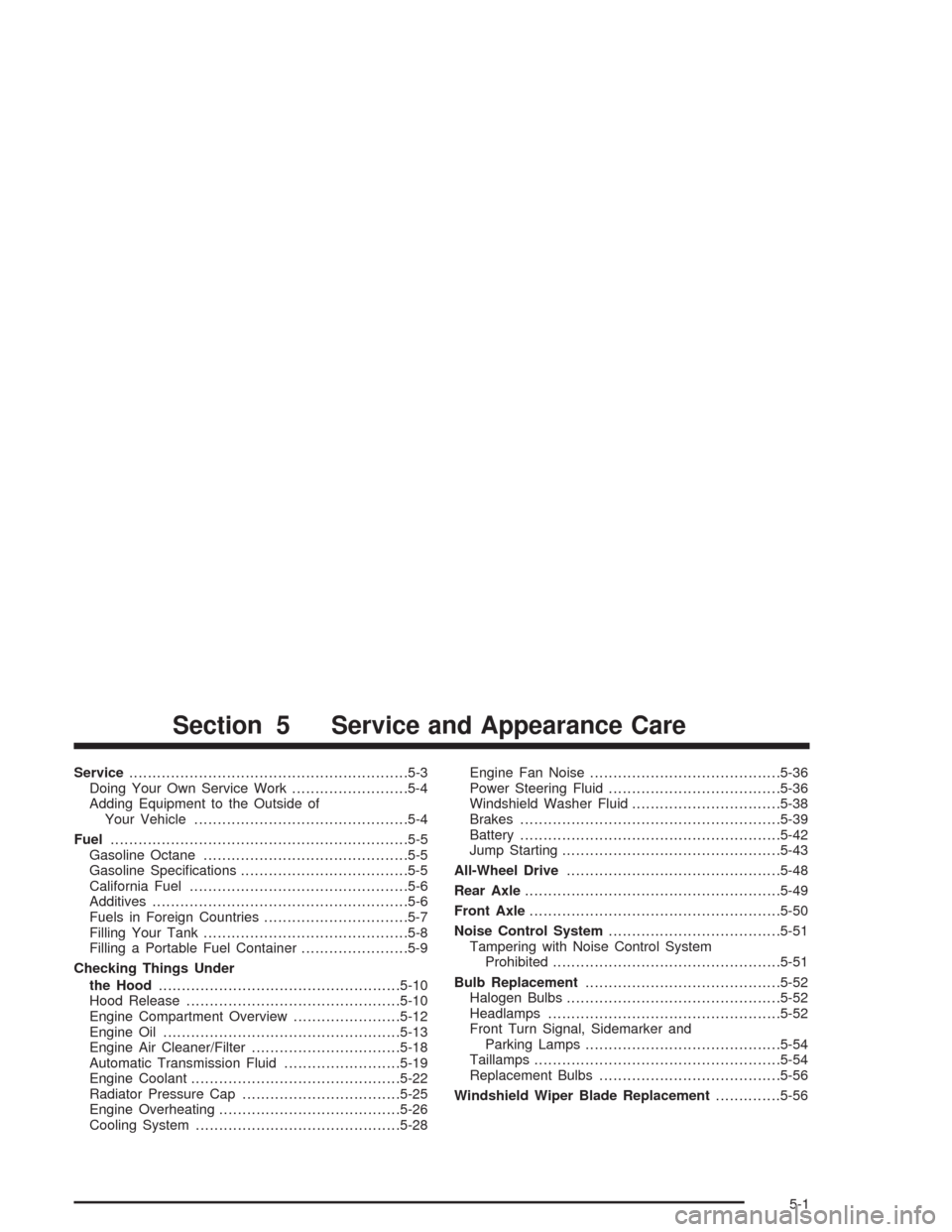
Service............................................................5-3
Doing Your Own Service Work.........................5-4
Adding Equipment to the Outside of
Your Vehicle..............................................5-4
Fuel................................................................5-5
Gasoline Octane............................................5-5
Gasoline Speci�cations....................................5-5
California Fuel...............................................5-6
Additives.......................................................5-6
Fuels in Foreign Countries...............................5-7
Filling Your Tank............................................5-8
Filling a Portable Fuel Container.......................5-9
Checking Things Under
the Hood....................................................5-10
Hood Release..............................................5-10
Engine Compartment Overview.......................5-12
Engine Oil...................................................5-13
Engine Air Cleaner/Filter................................5-18
Automatic Transmission Fluid.........................5-19
Engine Coolant.............................................5-22
Radiator Pressure Cap..................................5-25
Engine Overheating.......................................5-26
Cooling System............................................5-28Engine Fan Noise.........................................5-36
Power Steering Fluid.....................................5-36
Windshield Washer Fluid................................5-38
Brakes........................................................5-39
Battery........................................................5-42
Jump Starting...............................................5-43
All-Wheel Drive..............................................5-48
Rear Axle.......................................................5-49
Front Axle......................................................5-50
Noise Control System.....................................5-51
Tampering with Noise Control System
Prohibited.................................................5-51
Bulb Replacement..........................................5-52
Halogen Bulbs..............................................5-52
Headlamps..................................................5-52
Front Turn Signal, Sidemarker and
Parking Lamps..........................................5-54
Taillamps.....................................................5-54
Replacement Bulbs.......................................5-56
Windshield Wiper Blade Replacement..............5-56
Section 5 Service and Appearance Care
5-1
Page 265 of 406
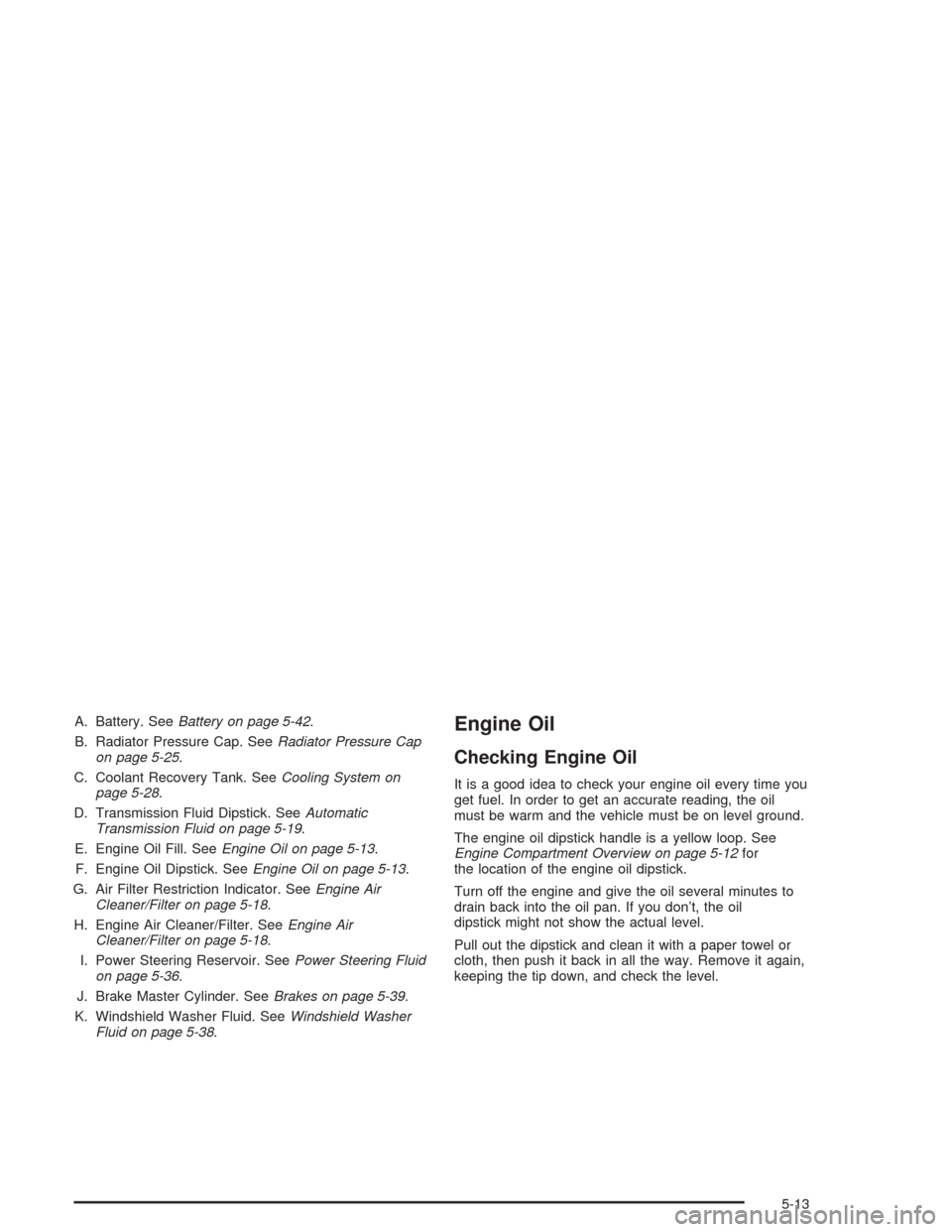
A. Battery. SeeBattery on page 5-42.
B. Radiator Pressure Cap. SeeRadiator Pressure Cap
on page 5-25.
C. Coolant Recovery Tank. SeeCooling System on
page 5-28.
D. Transmission Fluid Dipstick. SeeAutomatic
Transmission Fluid on page 5-19.
E. Engine Oil Fill. SeeEngine Oil on page 5-13.
F. Engine Oil Dipstick. SeeEngine Oil on page 5-13.
G. Air Filter Restriction Indicator. SeeEngine Air
Cleaner/Filter on page 5-18.
H. Engine Air Cleaner/Filter. SeeEngine Air
Cleaner/Filter on page 5-18.
I. Power Steering Reservoir. SeePower Steering Fluid
on page 5-36.
J. Brake Master Cylinder. SeeBrakes on page 5-39.
K. Windshield Washer Fluid. SeeWindshield Washer
Fluid on page 5-38.Engine Oil
Checking Engine Oil
It is a good idea to check your engine oil every time you
get fuel. In order to get an accurate reading, the oil
must be warm and the vehicle must be on level ground.
The engine oil dipstick handle is a yellow loop. See
Engine Compartment Overview on page 5-12for
the location of the engine oil dipstick.
Turn off the engine and give the oil several minutes to
drain back into the oil pan. If you don’t, the oil
dipstick might not show the actual level.
Pull out the dipstick and clean it with a paper towel or
cloth, then push it back in all the way. Remove it again,
keeping the tip down, and check the level.
5-13
Page 288 of 406
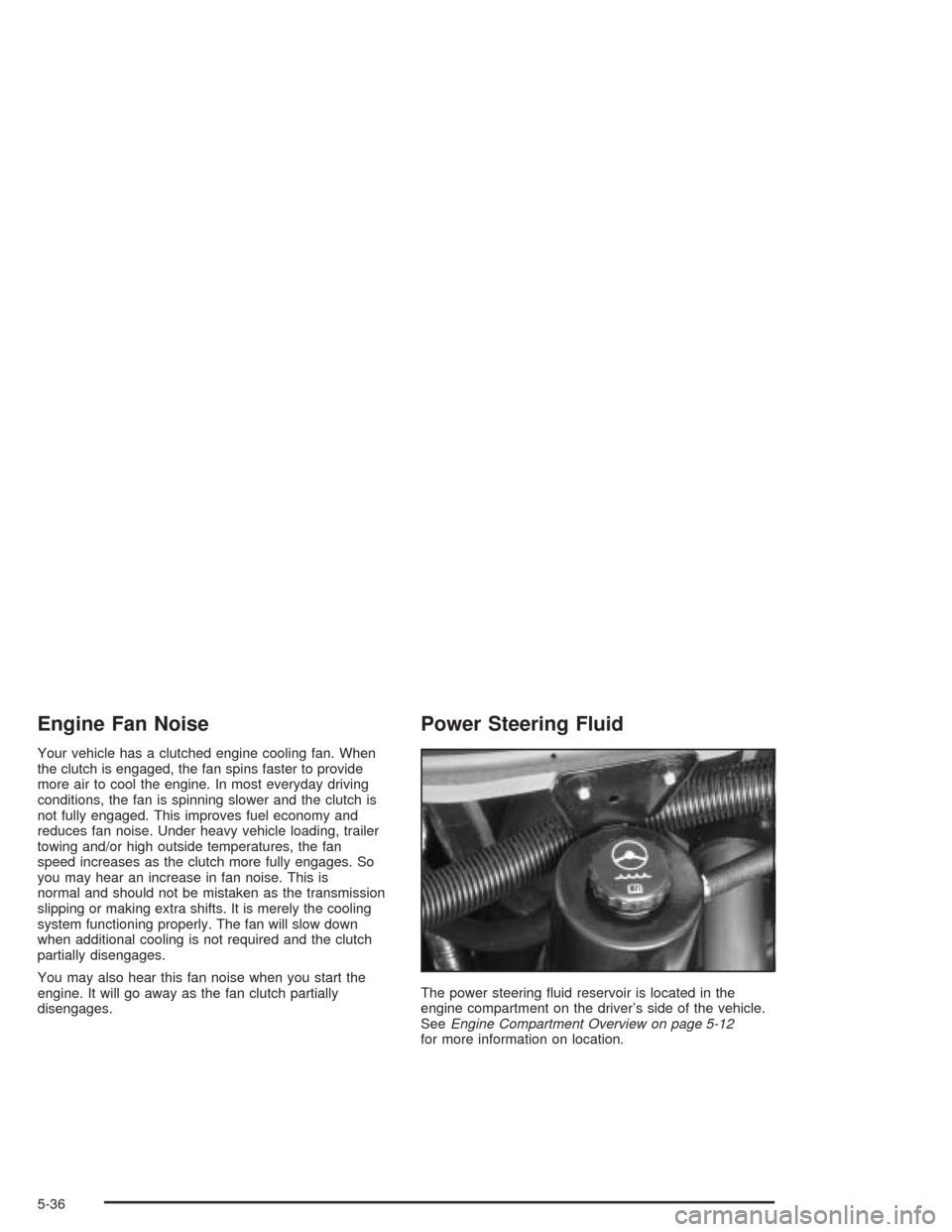
Engine Fan Noise
Your vehicle has a clutched engine cooling fan. When
the clutch is engaged, the fan spins faster to provide
more air to cool the engine. In most everyday driving
conditions, the fan is spinning slower and the clutch is
not fully engaged. This improves fuel economy and
reduces fan noise. Under heavy vehicle loading, trailer
towing and/or high outside temperatures, the fan
speed increases as the clutch more fully engages. So
you may hear an increase in fan noise. This is
normal and should not be mistaken as the transmission
slipping or making extra shifts. It is merely the cooling
system functioning properly. The fan will slow down
when additional cooling is not required and the clutch
partially disengages.
You may also hear this fan noise when you start the
engine. It will go away as the fan clutch partially
disengages.
Power Steering Fluid
The power steering �uid reservoir is located in the
engine compartment on the driver’s side of the vehicle.
SeeEngine Compartment Overview on page 5-12
for more information on location.
5-36
Page 289 of 406
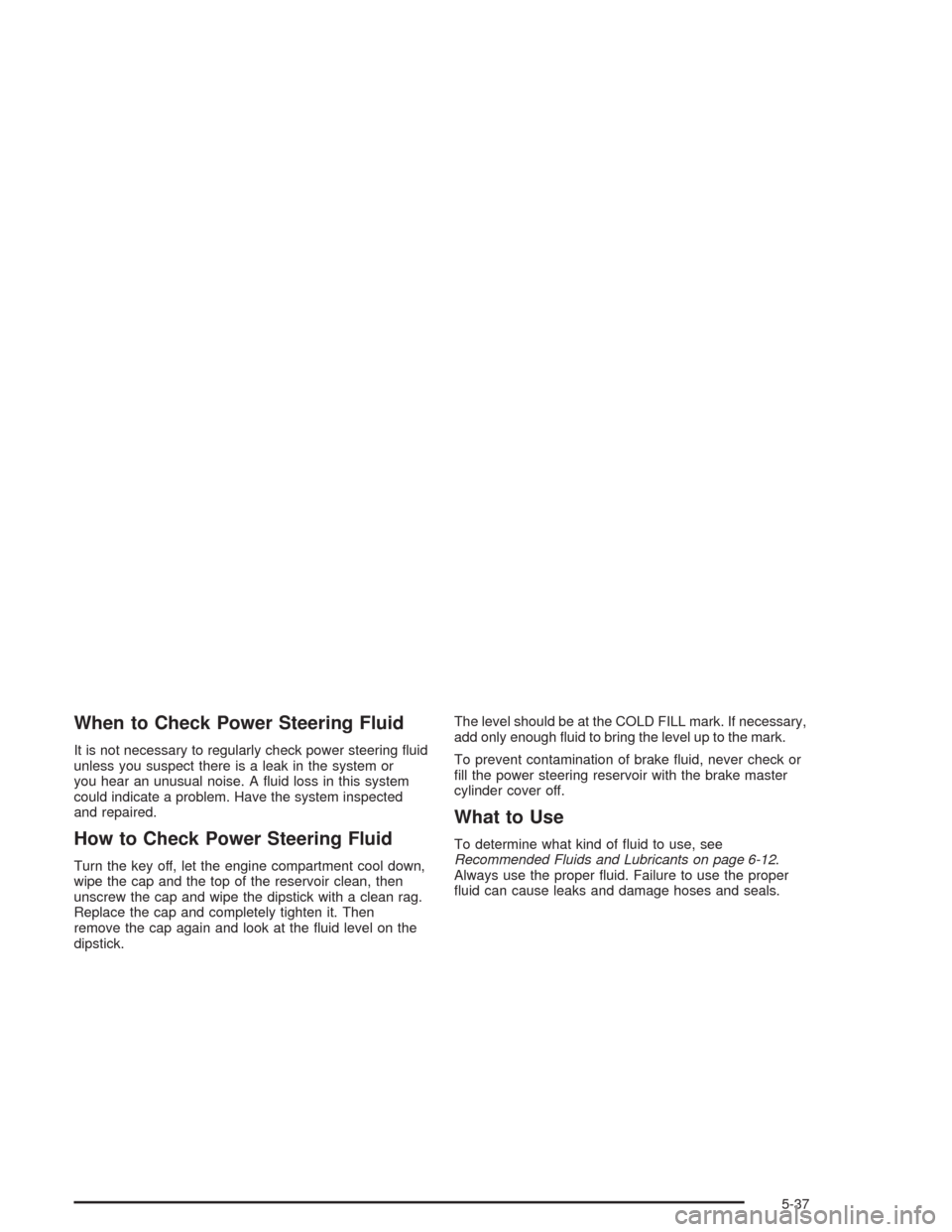
When to Check Power Steering Fluid
It is not necessary to regularly check power steering �uid
unless you suspect there is a leak in the system or
you hear an unusual noise. A �uid loss in this system
could indicate a problem. Have the system inspected
and repaired.
How to Check Power Steering Fluid
Turn the key off, let the engine compartment cool down,
wipe the cap and the top of the reservoir clean, then
unscrew the cap and wipe the dipstick with a clean rag.
Replace the cap and completely tighten it. Then
remove the cap again and look at the �uid level on the
dipstick.The level should be at the COLD FILL mark. If necessary,
add only enough �uid to bring the level up to the mark.
To prevent contamination of brake �uid, never check or
�ll the power steering reservoir with the brake master
cylinder cover off.
What to Use
To determine what kind of �uid to use, see
Recommended Fluids and Lubricants on page 6-12.
Always use the proper �uid. Failure to use the proper
�uid can cause leaks and damage hoses and seals.
5-37
Page 373 of 406
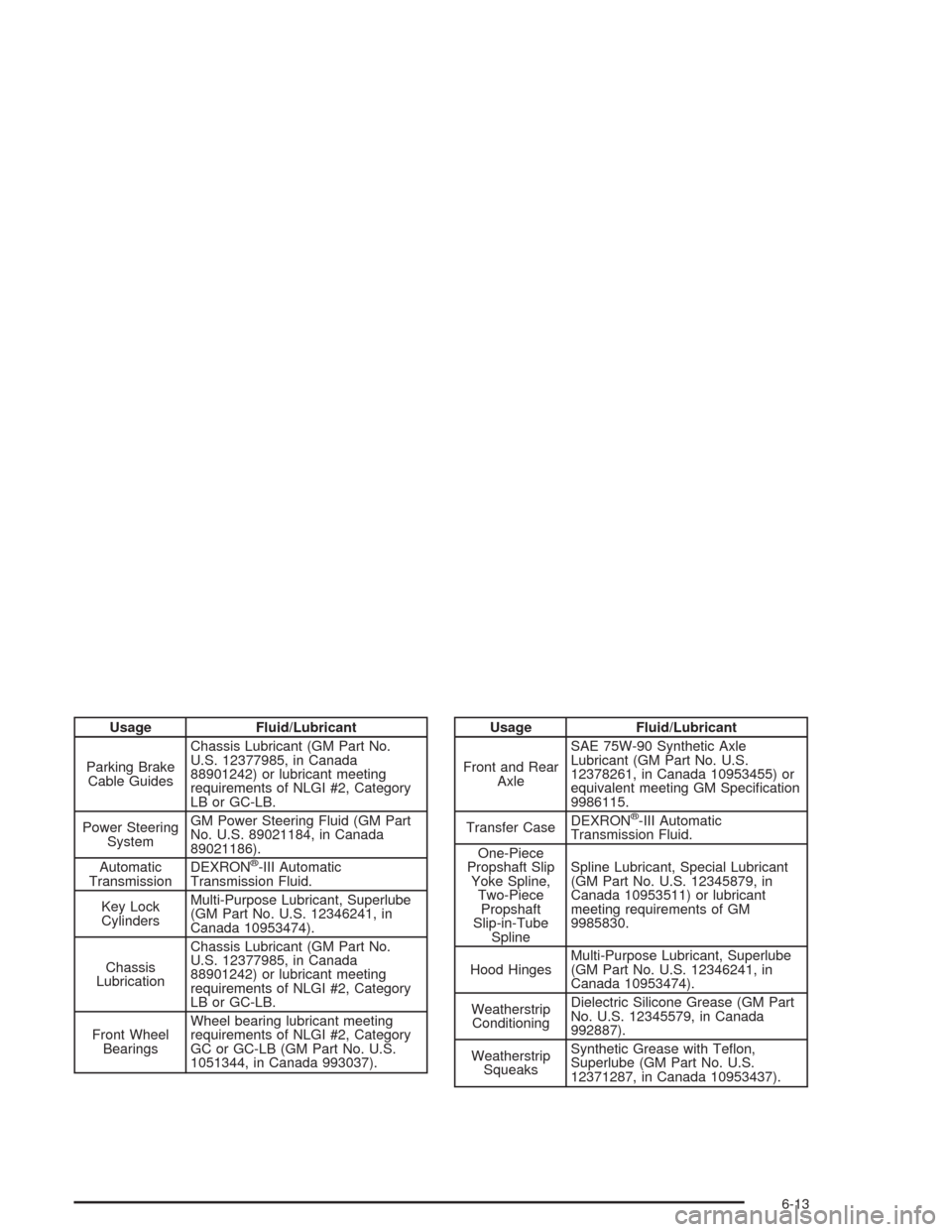
Usage Fluid/Lubricant
Parking Brake
Cable GuidesChassis Lubricant (GM Part No.
U.S. 12377985, in Canada
88901242) or lubricant meeting
requirements of NLGI #2, Category
LB or GC-LB.
Power Steering
SystemGM Power Steering Fluid (GM Part
No. U.S. 89021184, in Canada
89021186).
Automatic
TransmissionDEXRON
®-III Automatic
Transmission Fluid.
Key Lock
CylindersMulti-Purpose Lubricant, Superlube
(GM Part No. U.S. 12346241, in
Canada 10953474).
Chassis
LubricationChassis Lubricant (GM Part No.
U.S. 12377985, in Canada
88901242) or lubricant meeting
requirements of NLGI #2, Category
LB or GC-LB.
Front Wheel
BearingsWheel bearing lubricant meeting
requirements of NLGI #2, Category
GC or GC-LB (GM Part No. U.S.
1051344, in Canada 993037).
Usage Fluid/Lubricant
Front and Rear
AxleSAE 75W-90 Synthetic Axle
Lubricant (GM Part No. U.S.
12378261, in Canada 10953455) or
equivalent meeting GM Speci�cation
9986115.
Transfer CaseDEXRON
®-III Automatic
Transmission Fluid.
One-Piece
Propshaft Slip
Yoke Spline,
Two-Piece
Propshaft
Slip-in-Tube
SplineSpline Lubricant, Special Lubricant
(GM Part No. U.S. 12345879, in
Canada 10953511) or lubricant
meeting requirements of GM
9985830.
Hood HingesMulti-Purpose Lubricant, Superlube
(GM Part No. U.S. 12346241, in
Canada 10953474).
Weatherstrip
ConditioningDielectric Silicone Grease (GM Part
No. U.S. 12345579, in Canada
992887).
Weatherstrip
SqueaksSynthetic Grease with Te�on,
Superlube (GM Part No. U.S.
12371287, in Canada 10953437).
6-13
Page 397 of 406
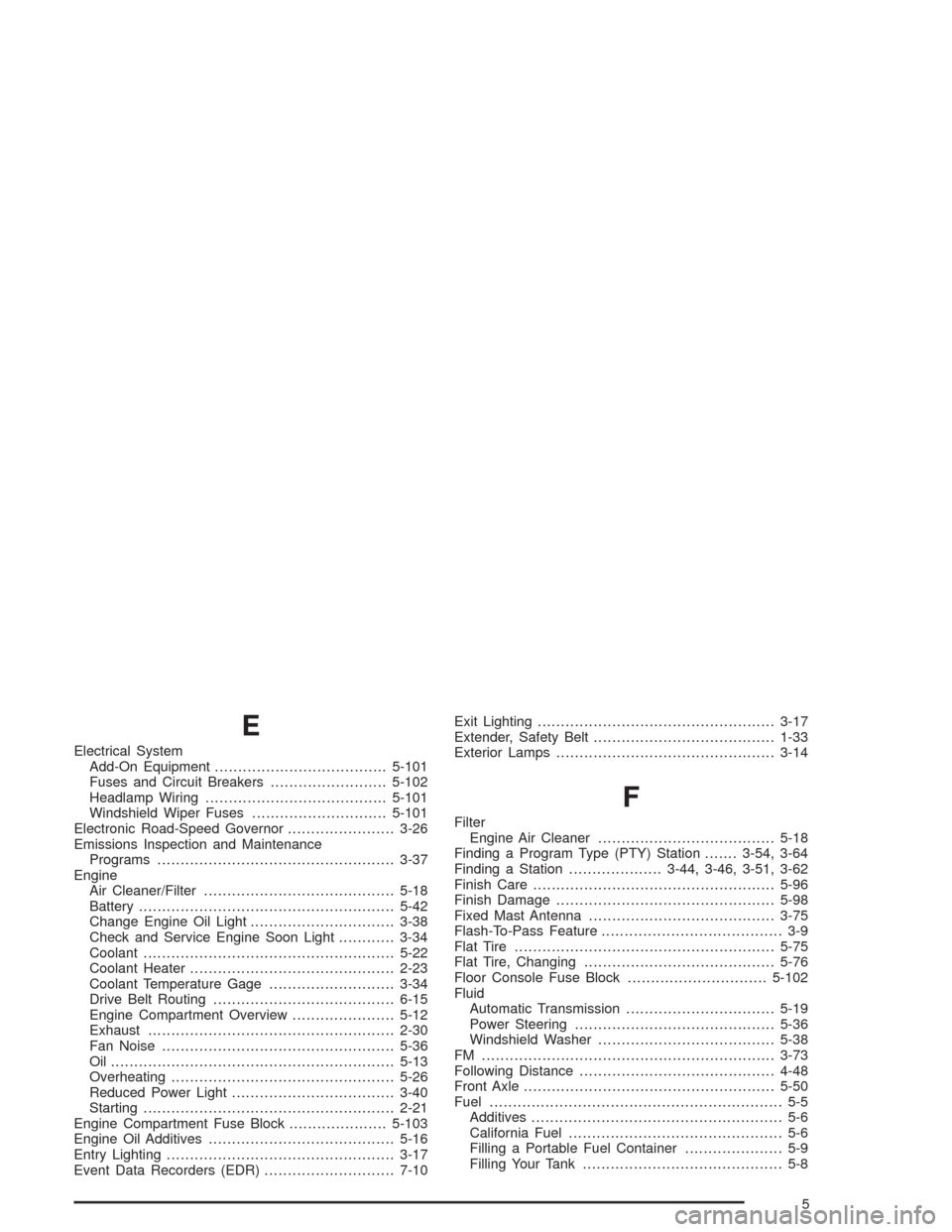
E
Electrical System
Add-On Equipment.....................................5-101
Fuses and Circuit Breakers.........................5-102
Headlamp Wiring.......................................5-101
Windshield Wiper Fuses.............................5-101
Electronic Road-Speed Governor.......................3-26
Emissions Inspection and Maintenance
Programs...................................................3-37
Engine
Air Cleaner/Filter.........................................5-18
Battery.......................................................5-42
Change Engine Oil Light...............................3-38
Check and Service Engine Soon Light............3-34
Coolant......................................................5-22
Coolant Heater............................................2-23
Coolant Temperature Gage...........................3-34
Drive Belt Routing.......................................6-15
Engine Compartment Overview......................5-12
Exhaust.....................................................2-30
Fan Noise..................................................5-36
Oil .............................................................5-13
Overheating................................................5-26
Reduced Power Light...................................3-40
Starting......................................................2-21
Engine Compartment Fuse Block.....................5-103
Engine Oil Additives........................................5-16
Entry Lighting.................................................3-17
Event Data Recorders (EDR)............................7-10Exit Lighting...................................................3-17
Extender, Safety Belt.......................................1-33
Exterior Lamps...............................................3-14
F
Filter
Engine Air Cleaner......................................5-18
Finding a Program Type (PTY) Station.......3-54, 3-64
Finding a Station....................3-44, 3-46, 3-51, 3-62
Finish Care....................................................5-96
Finish Damage...............................................5-98
Fixed Mast Antenna........................................3-75
Flash-To-Pass Feature....................................... 3-9
Flat Tire........................................................5-75
Flat Tire, Changing.........................................5-76
Floor Console Fuse Block..............................5-102
Fluid
Automatic Transmission................................5-19
Power Steering...........................................5-36
Windshield Washer......................................5-38
FM ...............................................................3-73
Following Distance..........................................4-48
Front Axle......................................................5-50
Fuel............................................................... 5-5
Additives...................................................... 5-6
California Fuel.............................................. 5-6
Filling a Portable Fuel Container..................... 5-9
Filling Your Tank........................................... 5-8
5
Page 398 of 406

Fuel (cont.)
Fuels in Foreign Countries.............................. 5-7
Gage.........................................................3-41
Gasoline Octane........................................... 5-5
Gasoline Speci�cations.................................. 5-5
Fuel Regulator................................................2-22
Fuses
Fuses and Circuit Breakers.........................5-102
Windshield Wiper.......................................5-101
G
Gage
Check Gages Warning Light..........................3-41
Engine Coolant Temperature.........................3-34
Fuel..........................................................3-41
Oil Pressure...............................................3-37
Speedometer..............................................3-26
Voltmeter Gage...........................................3-30
Gasoline
Octane........................................................ 5-5
Speci�cations............................................... 5-5
GM Mobility Program for Persons with
Disabilities.................................................... 7-6
H
Hazard Warning Flashers................................... 3-6
Headlamp High/Low Beam Changer.................... 3-9
Headlamp Wiring...........................................5-101
Headlamps....................................................5-52
Bulb Replacement.......................................5-52
Front Turn Signal, Sidemarker and
Parking Lamps.........................................5-54
Halogen Bulbs............................................5-52
Highway Hypnosis...........................................4-24
Hill and Mountain Roads..................................4-25
Hitches..........................................................4-46
Hood
Checking Things Under................................5-10
Release.....................................................5-10
Horn............................................................... 3-7
How to Add Coolant to the Coolant
Recovery Tank............................................5-30
How to Add Coolant to the Radiator..................5-33
How to Check Power Steering Fluid..................5-37
How to Inspect the Engine Air Cleaner/Filter.......5-18
How to Use This Manual...................................... ii
How to Wear Safety Belts Properly...................1-15
Hydroplaning..................................................4-20
6
Page 401 of 406
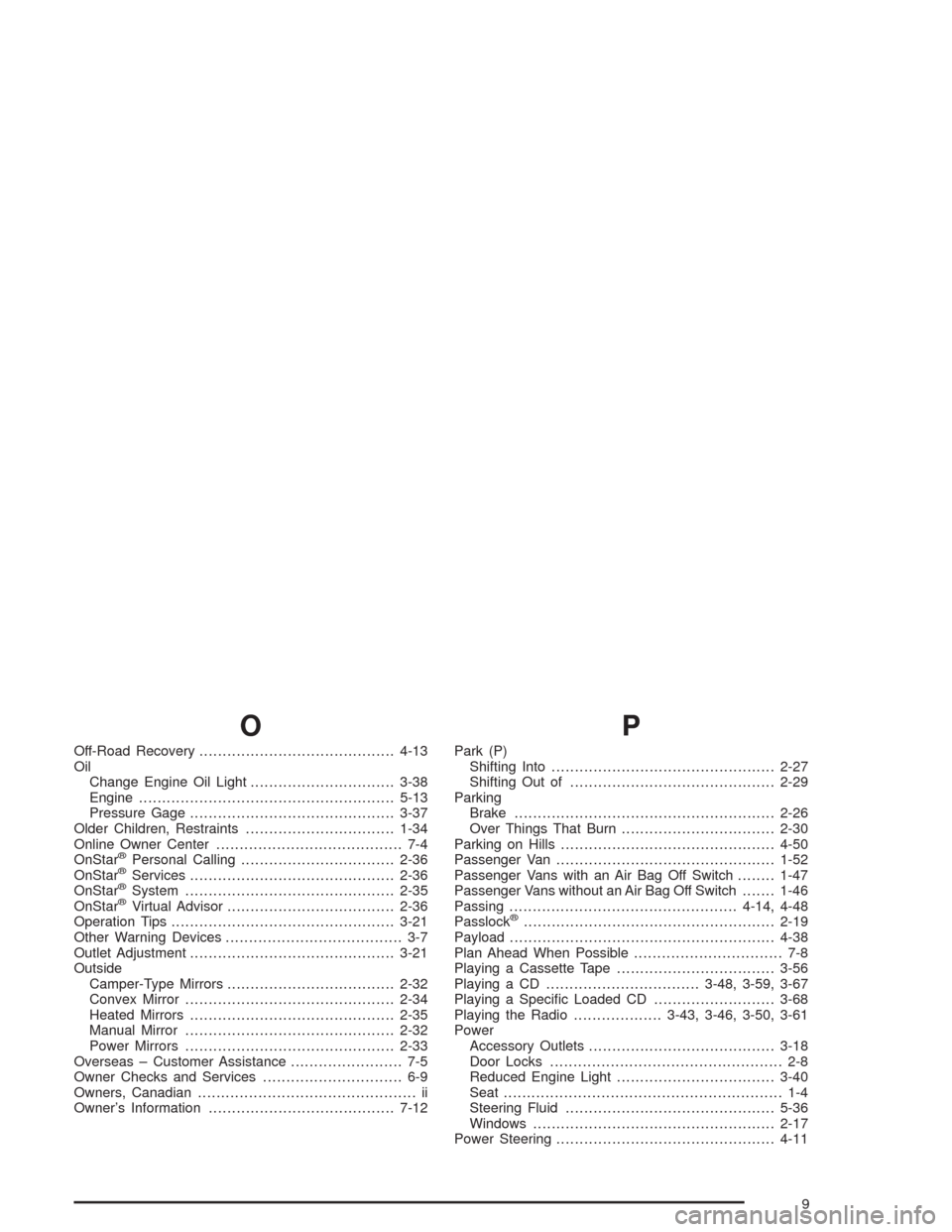
O
Off-Road Recovery..........................................4-13
Oil
Change Engine Oil Light...............................3-38
Engine.......................................................5-13
Pressure Gage............................................3-37
Older Children, Restraints................................1-34
Online Owner Center........................................ 7-4
OnStar
®Personal Calling.................................2-36
OnStar®Services............................................2-36
OnStar®System.............................................2-35
OnStar®Virtual Advisor....................................2-36
Operation Tips................................................3-21
Other Warning Devices...................................... 3-7
Outlet Adjustment............................................3-21
Outside
Camper-Type Mirrors....................................2-32
Convex Mirror.............................................2-34
Heated Mirrors............................................2-35
Manual Mirror.............................................2-32
Power Mirrors.............................................2-33
Overseas – Customer Assistance........................ 7-5
Owner Checks and Services.............................. 6-9
Owners, Canadian............................................... ii
Owner’s Information........................................7-12
P
Park (P)
Shifting Into................................................2-27
Shifting Out of............................................2-29
Parking
Brake........................................................2-26
Over Things That Burn.................................2-30
Parking on Hills..............................................4-50
Passenger Van...............................................1-52
Passenger Vans with an Air Bag Off Switch........1-47
Passenger Vans without an Air Bag Off Switch.......1-46
Passing.................................................4-14, 4-48
Passlock
®......................................................2-19
Payload.........................................................4-38
Plan Ahead When Possible................................ 7-8
Playing a Cassette Tape..................................3-56
Playing a CD.................................3-48, 3-59, 3-67
Playing a Speci�c Loaded CD..........................3-68
Playing the Radio...................3-43, 3-46, 3-50, 3-61
Power
Accessory Outlets........................................3-18
Door Locks.................................................. 2-8
Reduced Engine Light..................................3-40
Seat............................................................ 1-4
Steering Fluid.............................................5-36
Windows....................................................2-17
Power Steering...............................................4-11
9